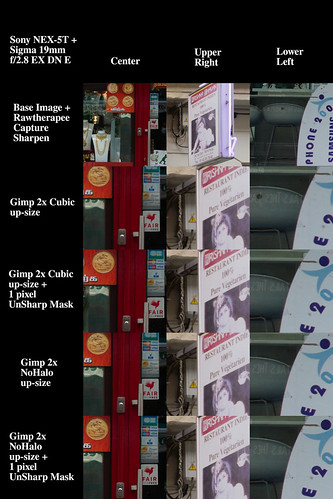Living where I do, I _know_ very much how fortunate I am to live in peace. There is mental space and physical safety to do the things I want. Like write these little blog entries. Not everyone has this option these days. I wish peace for everyone.
-------------------------OK. Enough background, theory, image simulations, and newspaper "tests". It's time to see if this thing has any legs.
Let's have a look at a simple snap I made on the streets of Paris recently after lunch up in the area we call "Little India." As an aside, if you need a recommendation for some really good south Indian dosa let me know. I might be able to suggest a place or two.
Materials -
- Sony NEX-5T 16mpixel camera (handheld)
- 19mm Sigma f/2.8 EX DN E lens
- Rawtherapee "Auto Matched Tone Curve" function
- Rawtherapee "Capture Sharpen" function
- Gimp to take Rawtherapee output and upsize using -
- CUBIC interpolation algorithm
- NoHalo interpolation algorithm
Comparison -
Here is the scene. I didn't put much effort into making the image. My stomach was full and the chai had me jump'n and jive'n, rather than concentrating on my surroundings. Still, I think is sufficient for the task here.
[As always, click on the image and open at 100percent to pixel-peep.]
Comments -
Redundantly Noted: Keep in mind that we are _not_ adding detail to an image by performing an up-size. In this way, I feel uncomfortable talking about Up-Rez'ing an image. Up-Sizing, yes. Up-Rez'ing, no. If the information isn't there in the base file, then it certainly will not be there in the up-sized image, either.
Another Note: I realize it may sound like I'm bashing Canon sensors in the following comments. Photography, however, is seldom just about the sensor. Witness the incredible volume of wonderful images that are made using Canon gear. If it were that bad, who would use it? But it's not bad and I'm only speaking in terms of comparison.
The first thing is that when I saw the first images out of a Sony A6000 APS-C camera some years ago, I immediately switched systems and sold all my Canon full frame and APS-C gear.
The second thing is a comment by Brooks Jensen noting that images readers sent to be considered for publication were sharpest when Nikon gear was used. Out of curiosity he was looking at the EXIF data to see if there were any trends, and apparently there were.
Starting with the base "Capture Sharpen"ed image we see that it is nice and "sharp" across the entire field. At low ISO and processed in this way this little Sony NEX-5T/Sigma 19mm f/2.8 EX DN combination is sharper than any of the old Canon DSLR L-glass'd gear I used to own. If I can't pull a fabulous print from this setup, I'm not trying hard enough. They are simply glorious, these old cameras and lenses.
Looking at the 2x (going from 4900 pixels on the long side to 9800 pixels) CUBIC up-size'd images, they appear "soft" to my eyes. Even the 1 pixel UnSharp Mask looks like it could be better. This confirms my earlier thoughts. Perhaps the Gimp's CUBIC isn't the best up-size interpolation algorithm? Well, if it was all we had, right?, but these days we have other options.
The NoHalo interpolation algorithm, on the other hand, looks better straight out of the up-size than the USM'd CUBIC image. Adding a 1 pixel USM to the NoHalo up-size? Well. Yes. This looks rather good, doesn't it?
The 2x up-sized NoHalo image reminds me very much of how my old Canon 5D MkII images looked in the Canon RAW viewer I used years ago. To be redundantly repetitive, this from an APS-C NEX-5T 16 mpixel image that is 2x up-sized to 9800pixels!


No comments:
Post a Comment